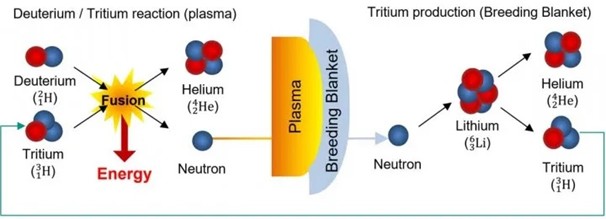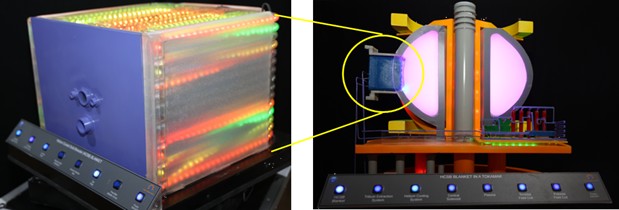Lithium Blanket Model
Lithium Blanket for Fusion Reactors
The exhibit shows the 1:5 scale model of a Helium Cooled Solid Breeder Blanket (HCSB) proposed for ITER. This model visualizes the lithium blanket used in a tokamak fusion device used to breed tritium which is one of the two fuels to be used in a fusion reactor (other fuel being Deuterium). Once the fusion reaction is initiated, half of the fuel, ie, Tritium, will be generated in this blanket. It is to be noted that Tritium (half-life of 12.33 years) is naturally produced in extremely small quantities in the atmosphere, comprising ~10?18 % of natural hydrogen. Hence one must find a ways to generate sufficient quantities of Tritium to run a fusion device. The first part of the model shows the structure of the blanket and the other part shows its location on the tokamak machine.
The model consists of alternatively stacked layers of Tritium breeding material (Ceramic Pebble bed of Lithium Meta-Titanate) and neutron multiplier (Beryllium pebble bed) with cooling plates in between. A U shaped Plasma Facing component called First wall consists of cooling channels. A five pass cooling circuit arrangement is made in the model to show the helium flow pattern. Three such cooling circuits are shown in the model. All the cooling plates and first wall circuits are connected to the manifolds at the back which distributes and collects helium coolant. A separate helium cooling system supplies the helium at desired pressure and temperature and also collects the heated coolant to extract energy from the coolant to generate electricity. Similarly tritium extraction system is also connected to the blanket which purges helium through the blanket to extract the tritium which is further supplied to the reactor fueling system to sustain the fusion reaction.
The primary fuel for a fusion reaction are isotopes of hydrogen, typically deuterium and tritium, which undergo nuclear fusion reactions to generate large amount of energy.
Deuterium + Tritium = Helium+ Neutron + Energy
Deuterium is a stable isotope of hydrogen and is readily available in water, is abundant and relatively easy to extract. Tritium is a radioactive isotope of hydrogen. While it is not naturally abundant, tritium can be produced by irradiating lithium in a fusion reactor. The neutrons cause reactions in the lithium-based breeding blanket material which results in the production of tritium. Lithium in the form of ceramic breeder pebble bed (Lithium Meta-Titanate) is used in solid breeder blanket to produce tritium and extract energy from neutrons.
The lithium embedded in the blanket will react with the neutron produced during fusion reaction to produce tritium. The breeding of tritium occurs through the reaction Li6 + Neutron = He4 + Tritium. This process is called "Transmutation". This would be advantageous because tritium is radioactive, with a short half-life, and so is difficult and expensive to obtain - it would be far more sensible to manufacture it onsite as a by-product of the fusion process.
The use of a tritium breeding solid blanket addresses the challenge of maintaining a self-sustaining fuel cycle in a fusion reactor. Neutron multiplier is required to increase the efficiency of tritium breeding. Helium coolant is used to extract the heat produced by interaction of neutrons with different materials (functional and structural) in the blanket
|
 Schematic of how Tritium breeding is done in a fusion reactor
| |
 | |
(L) the breeder cassette showing the lithium pebbles and cooling channels
| The cross-section of a fusion device showing the location of the breeder blanket
|
© IPR, 2017-18
Home Academic Visits | IPR Outreach | Comic Book | Exhibition Hall | Plasma Exhibition | People | Resource Materials | NSD-2025 | Social Outreach | Solar Telescope | Training Program | TokoToy | Vigyan Samagam | 2022 Events | 2023 Events | 2024 Events | 2025 Events | Upcoming Events | FAQ FAQ | Contact Contact | Ask A Question Ask A Question | Talk 2 Us Interact with a Plasma Scientist |
